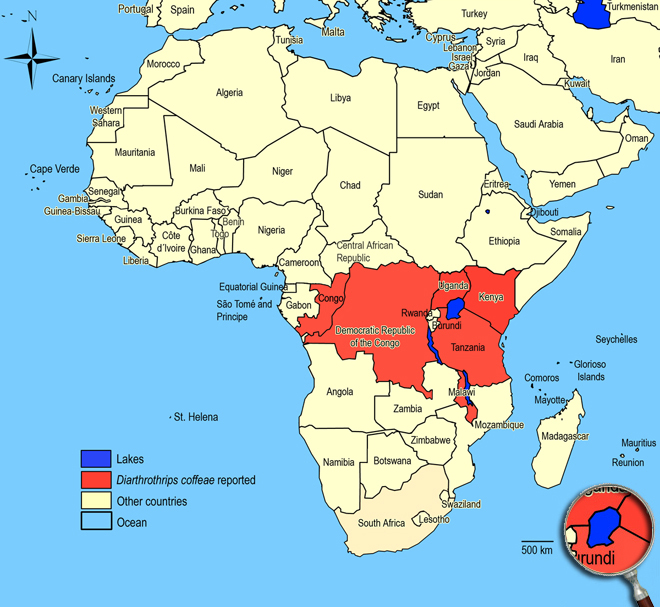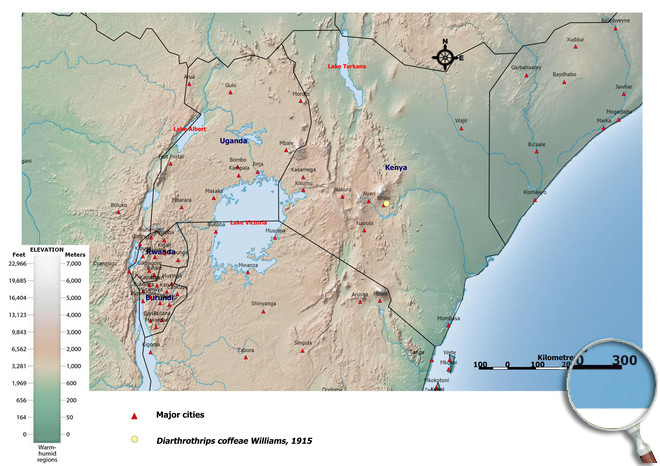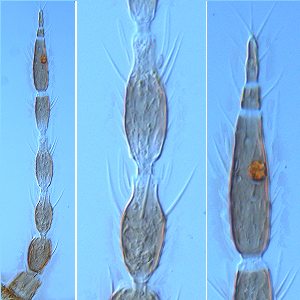Diarthrothrips coffeae Williams, 1915
Thripinae, Thripidae, Terebrantia, Thysanoptera
Figures
Fig. 1: 8-segmented antenna, segments III and IV with forked sense cone, terminal segments VI-VIII
Fig. 2: Head dorsal with ocellar triangle
Fig. 3: Head ventral with mouthcone
Fig. 4: Pronotum
Fig. 5: Meso- and metanotum
Fig. 6: Meso- and metasternum with furca and spinula
Fig. 7: Fore wing, apex region of fore wing
Fig. 8: Tergites IV-VI
Fig. 9: Sternites II-IV
Fig. 10: Sternites VI and VII
Fig. 11: Tergites IX and X
Fig. 12: Tergites VIII-XI
Introduction and recognition
Diarthrothrips coffeae attacks leaves, twigs and berries of Arabica coffee in East Africa. Both sexes fully winged. Body pale to dark brown; abdomen, except for the last three segments, a little darker; antennae rather darker than the body with apex of segments III & IV and base of segment V paler, segments IV & V with a more or less clear ring near the base which separated off narrow darker ring at the base; legs paler than the body; fore wings pale yellowish with 2, sometimes indistinct, small dark areas - one at the base of second vein and another in the posterior half of fore wing. Antennae 8-segmented; segments III & IV with slender forked sensorium (Fig. 1). Head about as long as wide; 3 pairs of ocellar setae, pair I quite short, II & III long and slender, pair III arise within ocellar triangle anterior to tangent of anterior margin of hind ocelli (Fig. 2 and 3). Pronotum not reticulate; with 2 pairs of elongate posteroangular setae (Fig. 4). Metanotum median area weakly sculptured; median setae small and arising well behind anterior margin (Fig. 5). Meso- and metafurca with median spinula (Fig. 6). Mid and hind tarsi 2-segmented. Fore wing first vein with a long gap in setal row, 5 setae basally and 2 distally; second vein with complete row of 12-16 setae (Fig. 7). Tergites with median pair of setae shorter than distance between their bases (Fig. 8); posterior margin of VIII without a comb of microtrichia (Fig. 11); tergite X with no longitudinal split (Fig. 12). Sternites without discal setae; long median setae on sternite VII arising in front of hind margin (Fig. 9).
Male paler and smaller than female; without glandular areas.
Taxonomic identity
Species
Diarthrothrips coffeae Williams, 1915
Taxonomic history
-
Common name
Coffee thrips
Present taxonomic position
Family: Thripidae Stephens, 1829
Subfamily: Thripinae (Stephens) Karny, 1921
Genus: Diarthrothrips Williams, 1915
Genus description
The genus Diarthrothrips Williams, 1915
There are only 2 species in this genus, one from India and another from East and West Africa. Both have 8-segmented antennae, antennal segments III & IV with slender forked sense cone, antennal segments IV & V with a clear ring near the base which separated off narrow darker ring at the base, 3 pairs of ocellar setae on head, 2 pairs of elongate posteroangular pronotal setae, and the meso- and metathorax with a well developed internal spinula.
Species description
Typical key character states of Diarthrothrips coffeae
Coloration and body sculpture
Body color: mainly brown to dark brown or pale to yellow, or with some darker markings
Surface of head, pronotum and fore legs: without obvious or with weakly reticulate sculpture
Antennae
Form of sense cones on antennal segments III and IV: emergent and forked on segments III and IV
Number of antennal segments: 8
Antennal segment I: without any setae on dorsal apical margin
Antennal segment II: without an exceptionally long seta at the inner apex
Antennal segment II shape: symmetric
Antennal segment III shape: symmetric
Length of antennal segment III and IV: antennal segment III similar in length to segment IV
Forked sense cone on antennal segment IV: scarcely extending beyond base of segment V
Antennal segment IV and V: with a hyaline ring near the base which separated off narrow darker ring
Antennal segment VI bears: not a remarkably dagger-shaped sensorium
Head
Distance between bases of ocellar setae III: greater than width of first ocellus
Head: not prolonged in front of compound eyes
Ocellar setae I: present
Ocellar setae III: arising within ocellar triangle anterior to tangent of anterior margin of hind ocelli
Ocelli: present
Head length to wide: length = width
Length of postocular setae: not alternating short and long setae
Number of ocellar setae: 3
Prothorax
Number of pairs of long anteroangular setae: 1-2
Number of pairs of long posteroangular setae: 2
Number of pairs of elongate pronotal setae: 3-4
Number of pairs of posteromarginal minor setae: 2-3
Pronotal blotch or internal apodeme: absent
Pronotum shape: broadly rectangular
Mesothorax
Mesosternal furca: with median spinula
Metathorax
Metanotal median setae: S1 behind anterior margin
Metanotum with dominant sculptured triangle medially: absent
Metasternal furca: with spinula
Shape of metathoracic furca: transverse, V-shaped
Wings
Fore and hind wings: present, more than half as long as abdomen (macropterous)
Fringe cilia arising: from sockets
Fore wing veins: present
Fore- and hind wing surface: covered with microtrichia
Apex of fore wing: with prominent terminal setae
Fore wing anterior margin (costal vein): with setae and cilia but cilia longer than setae
Fore wing costal fringe cilia: arising at anterior margin of wing
Fore wing first vein: distinct from costal vein
Fore wing first vein setal row: incomplete, with setae not closely and uniformly spaced
Fore wing number of setae of second vein: 12-16
Fore wing second vein setal row: complete, setae uniformly spaced
Fore wing shape: mainly parallel sided or margins run continuously towards each other
Fore wing surface: not reticulate
Fore wing first vein number of setae on distal half: 2
Fringe cilia on posterior margin near apex: distinctly wavy (undulated)
Length of fore wing costal setae at middle of wing: longer than half of median wing width
Shape of fore wing apex: with mainly posterior margin curved to join anterior margin
Fore wing extreme apex color: pale
Fore wings: pale with dark area(s) or uniformly pale or weakly shaded
Legs
Fore tibia: not prolonged around fore tarsus
Mid and hind tarsi: with two segments
Color of fore tarsi: pale or yellow, sometimes apical shaded or brown
Abdomen
Pleurotergites: not covered in microtrichia
Sternite II: with marginal setae but no discal setae
Sternites IV, V and VI: with marginal setae but no discal setae
Sternite VII median posteromarginal setae S1: arising in front of posterior margin
Sternite VII: with marginal setae but no discal setae
Surface of lateral thirds of abdominal tergites: without regular rows of fine microtrichia
Tergites II to VII median setal pair: no more than 0.3 as long as median length of tergite
Craspedum on tergites IV to VI: absent
Tergites IV and V median setal pair: shorter than distance between their bases
Tergites V to VII: without ctenidia laterally, but sometimes with rows of microtrichia
Tergite VIII ctenidia: without paired ctenidia laterally, sometimes with irregular microtrichia
Tergite VIII posteromarginal comb of microtrichia: absent
Craspedum on tergite VIII: without craspedum medially and toothlike microtrichia laterally
Tergite X: not tubular, longitudinally incomplete
Setae on abdominal tergite X: all setae slender

Similar or related species
Diarthrothrips coffeae is similar to Chirothrips guillarmodi, Scolothrips rhagebianus and species of Craspedothrips in having 8-segmented antennae with forked sense cone on segments III and IV, 2 pairs of elongate posteroangular pronotal setae, lateral thirds of tergites without regular rows of fine microtrichia, and tergite VIII without paired ctenidia laterally and without posteromarginal comb of microtrichia. But Chirothrips guillarmodi has a trapezoidal pronotum, and the meso- and metafurca are without median spinula. Scolothrips rhagebianus possesses altogether 6 pairs of elongate pronotal setae, and fore wing costal setae at middle of wing are about twice or more as long as median wing width. And species of Craspedothrips have the metasternal furca without median spinula.
Biology
Life history
As with other thrips species the life cycle from egg to adult is dependent on temperature. The full cycle can take less than one week to over a month and adults may live for more than one month producing several generations in one year depending on seasonal weather (Lewis 1973).
Host plants
Coffee (Coffea arabica).
Vector capacity
None identified, but possible mechanical distribution of phytopathogenic fungi and bacteria.
Damage and symptoms
Attacks especially under sides of leaves, and in severe cases the upper sides of leaves, berries and green shoots, with irregular grey or silvery patches covered by minute black spots. Death of leaves and total leaf-fall may follow a very heavy infestation (Hill 1983).
Detection and control strategies
Control by mulching the coffee trees with elephant grass and application of dicrotophos, fenitrothion or parathion (Kranz et al. 1977).
Mulching with a suitable material, such as banana leaves or cut dried grass, may help to improve soil conditions by increasing soil fertility, reducing soil acidity, conserving soil moisture and protecting the soil from compaction and surface erosion due to run-off water. Mulching can also have a direct effect on pest population. It appears that populations of coffee thrips, which thrive under hot, dry conditions, are reduced in the cooler, humid conditions of a mulched field (Magina 2005).
Mulching reduces thrips numbers considerably and its widespread use in recent years is probably a reason for the declining importance of this pest. Non-persistent insecticides such a fenitrothion and fenithion give effective thrips control for only a few days after spraying. DDT or dieldrin were used earlier for their management, despite the risk of causing outbreaks of other pests (Hill 1983).
Additional notes
-
Biogeography
East Africa. Congo,
Kenya (Kabete),
Malawi,
Tanzania,
Uganda.
African countries where Diarthrothrips coffeae has been reported

Occurence of Diarthrothrips coffeae in East Africa

Please click here for survey sites of all observed thrips species of Kenya, Tanzania and Uganda.
Click here for locations of Diarthrothrips coffeae in parts of East Africa.

Bibliography
Hill D (1983). Agricultural insect pests of the tropics and their control, (2nd edition). Cambridge University Press, Cambridge, 746 pp
Kranz J, Schmutterer H & Koch W (1977). Diseases, pests and weeds in tropical crops. Paul Parey, Berlin & Hamburg, 666 pp
le Pelley RH (1969). Pests of coffee. Tropical Science Series. Longmans, London, 590 pp
Lewis T (1973). Thrips: their biology, ecology and economic importance. Academic Press Inc., London Ltd., 349 pp
Lewis T (1997). Thrips as crop pests. CAB International, Wallingford, 740 pp
Magina FL (2005). A review of coffe pest managment. Tanzania Coffee Research Institute, Lyamungu, 39 pp
Palmer JM (1990). Identification of the common thrips of Tropical Africa (Thysanoptera, Insecta). Tropical Pest Management. 36 (1): 27-49
Williams CB (1915). A new thrips damaging coffee in British East Africa. Bulletin of Entomological Research. 6: 269-272
----
Web links
Mound´s Thysanoptera pages
Thysanoptera Checklist
ICIPE Thrips survey sites
UNI Halle & Thrips sites
Thrips of California
















